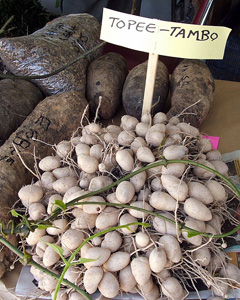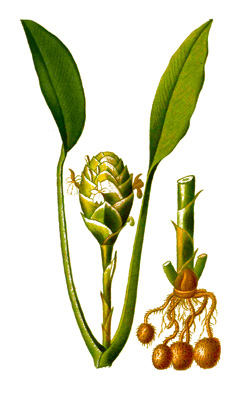 |
|
https://edibleplants.org/ |
 |
| https://edibleplants.org/ |
Translate this page:
Summary
Sweetcorn Root or Calathea allouia is a tropical, perennial plant that grows up tp 1.5 m tall. It is native to northern South America and the Caribbean. Other common names include Guinea arrowroot, Alleluia, and Aria. Tuberous and egg shaped roots have high starch content and are consumed when cooked. Young tender flower spikes are also cooked. The leaves are large and used as tamales wrap. The flowers are white and in spiral.
Physical Characteristics

 Calathea allouia is an evergreen Perennial growing to 2 m (6ft) by 1 m (3ft 3in) at a medium rate.
Calathea allouia is an evergreen Perennial growing to 2 m (6ft) by 1 m (3ft 3in) at a medium rate.
See above for USDA hardiness. It is hardy to UK zone 10.
Suitable for: light (sandy), medium (loamy) and heavy (clay) soils and prefers well-drained soil. Suitable pH: mildly acid, neutral and basic (mildly alkaline) soils and can grow in very acid and very alkaline soils.
It can grow in semi-shade (light woodland) or no shade. It prefers moist soil.
UK Hardiness Map
US Hardiness Map
Synonyms
Maranta allouia Aubl.; Phrynium allouia Aubl.; Also as Allouya americana (Lamk.); Curcuma americana
Plant Habitats
Edible Uses
Edible Parts: Flowers Leaves Root
Edible Uses:
Edible portion: Tubers, Root, Flowers, Leaves - flavour, Vegetable. Root - cooked[ 46 ]. Rich in starch[ 317 ]. The crisp cooked tubers are very agreeable with a flavour like sweetcorn[ 301 ]. It is used in salads, stews and fish dishes. Their unique texture makes them a gourmet item[ 301 ]. Used in similar ways to potatoes[ 200 ]. A commercially cultivated vegetable. The tubers are 2 - 8cm long and 2 - 4cm in diameter[ 418 ]. Young tender flower spikes - cooked[ 301 , 331 ]. The leaves are used for wrapping tamales and other foods, to which they impart flavour[ 301 , 331 ]. Tubers are 6.6% protein on a dry matter basis.
References More on Edible Uses
Medicinal Uses
Plants For A Future can not take any responsibility for any adverse effects from the use of plants. Always seek advice from a professional before using a plant medicinally.
None known
References More on Medicinal Uses
The Bookshop: Edible Plant Books
Our Latest books on Perennial Plants For Food Forests and Permaculture Gardens in paperback or digital formats.

Edible Tropical Plants
Food Forest Plants for Hotter Conditions: 250+ Plants For Tropical Food Forests & Permaculture Gardens.
More

Edible Temperate Plants
Plants for Your Food Forest: 500 Plants for Temperate Food Forests & Permaculture Gardens.
More

More Books
PFAF have eight books available in paperback and digital formats. Browse the shop for more information.
Shop Now
Other Uses
Basketry
Other uses rating: Low (1/5). In former times, the plant played a more important role for making blankets, mattresses, pillows, baskets and umbrellas[ 317 ].
Special Uses
References More on Other Uses
Cultivation details
A plant mainly of the moist, lowland tropics, where it is found at elevations up to 1,400 metres. It grows best in areas where annual daytime temperatures are within the range 22 - 31c, but can tolerate 16 - 35c[ 418 ]. It prefers a mean annual rainfall in the range 1,000 - 2,000mm, but tolerates 700 - 2,800mm[ 418 ]. Grows best in full sun or light shade[ 418 ]. Prefers a moist, humus-rich, freely-draining soil[ 200 ]. Prefers a pH in the range 6 - 7, tolerating 5.5 - 7.5[ 418 ]. Crops are produced in about 9 - 14 months from planting out the roots[ 418 ]. Tuber yields of 2 - 15 tonnes/ha have been reported[ 418 ].
References Carbon Farming Information and Carbon Sequestration Information
Temperature Converter
Type a value in the Celsius field to convert the value to Fahrenheit:
Fahrenheit:
The PFAF Bookshop
Plants For A Future have a number of books available in paperback and digital form. Book titles include Edible Plants, Edible Perennials, Edible Trees,Edible Shrubs, Woodland Gardening, and Temperate Food Forest Plants. Our new book is Food Forest Plants For Hotter Conditions (Tropical and Sub-Tropical).
Shop Now
Plant Propagation
Seed - Division of tubers Cuttings of basal shoots.
Other Names
If available other names are mentioned here
Sweetcorn Root or Calathea allouia. Other Names: Agua bendita, Allelouia, Alleluia, Aria, Cocurito, Curcuma d'Amerique, Dale dale, Dali dali, Guinea arrowroot, Lairem, Laren, Leren, Lerenes, Lleren, Sweet corn root, Sweet-corm-root, Topee Tambu, Topi-tambu, Topinambour.
Native Range
SOUTHERN AMERICA: Hispaniola, Cuba, Dominica, Guadeloupe, Martinique, Trinidad and Tobago (Trinidad), United States (Puerto Rico), St. Vincent and Grenadines (Saint Vincent), French Guiana, Venezuela, Brazil, Colombia, Peru
Weed Potential
Right plant wrong place. We are currently updating this section.
Please note that a plant may be invasive in one area but may not in your area so it's worth checking.
None Known
Conservation Status
IUCN Red List of Threatened Plants Status : This taxon has not yet been assessed.

Growth: S = slow M = medium F = fast. Soil: L = light (sandy) M = medium H = heavy (clay). pH: A = acid N = neutral B = basic (alkaline). Shade: F = full shade S = semi-shade N = no shade. Moisture: D = dry M = Moist We = wet Wa = water.
Now available:
Food Forest Plants for Mediterranean Conditions
350+ Perennial Plants For Mediterranean and Drier Food Forests and Permaculture Gardens.
[Paperback and eBook]
This is the third in Plants For A Future's series of plant guides for food forests tailored to
specific climate zones. Following volumes on temperate and tropical ecosystems, this book focuses
on species suited to Mediterranean conditions—regions with hot, dry summers and cool, wet winters,
often facing the added challenge of climate change.
Read More
Expert comment
Author
(Aubl.) Lindl.
Botanical References
Links / References
For a list of references used on this page please go here
A special thanks to Ken Fern for some of the information used on this page.
Readers comment
| Add a comment |
|
If you have important information about this plant that may help other users please add a comment or link below. Only comments or links that are felt to be directly relevant to a plant will be included. If you think a comment/link or information contained on this page is inaccurate or misleading we would welcome your feedback at [email protected]. If you have questions about a plant please use the Forum on this website as we do not have the resources to answer questions ourselves.
* Please note: the comments by website users are not necessarily those held by PFAF and may give misleading or inaccurate information.
To leave a comment please Register or login here All comments need to be approved so will not appear immediately.
|
Subject : Calathea allouia
|
|
|
|